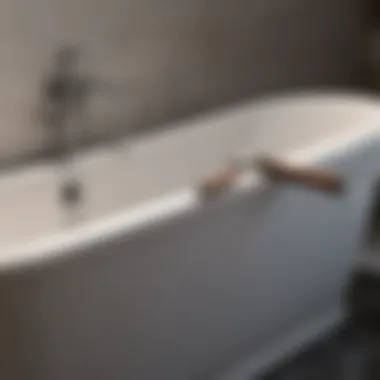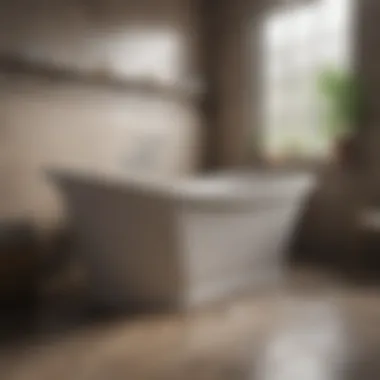Effective Techniques to Unstop a Bathtub


Intro
Bathtubs are a staple in many homes, offering a place for relaxation and cleansing. However, clogs can happen. The stoppage of water flow is frustrating. Understanding the effective techniques to unclog a bathtub is essential.
Homeowners often overlook the reasons behind these blockages. The causes can range from hair accumulation to soap scum buildup. Recognizing these is the first step towards resolving the issue.
This guide will clarify various methods for tackling bathtub clogs, from simple DIY approaches to more hands-on techniques. The goal is to provide readers the tools to ensure their bathtubs work smoothly. By addressing these issues, one can maintain not only the functionality of the bathtub but also its aesthetic value.
Key Components to Consider
There are several aspects that need to be understood. These include the different types of clogs and the tools that can make the problem easier to solve. Furthermore, preventive measures play a crucial role in avoiding future clogs. Understanding these factors creates a solid foundation for the article.
"An ounce of prevention is worth a pound of cure." - Benjamin Franklin
Article Structure
This article is organized to first discuss the potential causes of clogs, followed by practical techniques for unclogging. In the end, we will address how to prevent these issues from recurring, securing both your time and peace of mind.
Read on to uncover effective techniques to maintain your bathtub, keeping it as a functional, elegant part of your home.
Understanding Bathtub Clogs
Understanding bathtub clogs is essential for maintaining the functionality and hygiene of one’s home. Bathtub clogs are not just an annoyance; they can lead to significant water damage and costly repairs if left unaddressed. Identifying the cause of a clog is the first step toward effective resolution. Moreover, knowledge of common clogging factors allows homeowners to take preventative measures. This section aims to provide insights into the numerous reasons behind bathtub clogs and how these can impact overall plumbing health.
Common Causes of Bathtub Clogs
There are various reasons why bathtubs become clogged. Some of the more frequent culprits include:
- Hair: One of the primary contributors to bathtub clogs. Hair collects over time, forming a dense ball that blocks drainage.
- Soap residue: Soap can react with hard water minerals, creating a slippery buildup that can aggravate clogs.
- Bathroom products: Items like toothpaste, shavings from razors, or other products inadvertently washed down can contribute to the blockage.
- Mineral deposits: Hard water leads to the accumulation of minerals in the pipes, which narrows the flow and creates a higher likelihood of blockage.
By recognizing these common causes, timely action can be taken to avoid escalation.
How Hair and Soap Residue Accumulate
Hair and soap residue often accumulate due to everyday use. Every time a person bathes or showers, strands of hair may fall, and the soap can dissolve partially in water, leading to a sticky residue in the pipes. Over time, these substances work together to form clumps. The initial accumulation may seem minor, but it gradually grows, obstructing water flow.
Regular maintenance—like using drain covers or cleaning out visible clogs—can significantly minimize this type of buildup. Maintenance efforts can greatly affect the longevity of the drainage system.
Impact of Hard Water on Drainage
Hard water contains high levels of minerals such as calcium and magnesium. This type of water can leave deposits in pipes over time, leading to reduced drainage efficiency. When hard water interacts with soap, it can create soap scum which solidifies along the tub and pipes. The presence of this buildup may create an aggressive cycle, where blocking leads to even slower drainage.
To alleviate these issues, homeowners may consider water softening systems. Regular descaling can also help in preventing significant mineral deposits from forming. These practices may seem tedious but often prove worthwhile in safeguarding against major plumbing issues.
Initial Assessment of the Clog


Before selecting any technique to unclog a bathtub, it is vital to conduct an initial assessment of the clog. This assessment serves as the foundation for effective intervention. Understanding the nature of the clog helps in determining the right tools, methods, and potential complications that may arise. Ignoring this step could lead to wasted effort, further damage, or an escalation of the problem.
An effective assessment involves recognizing the signs of blockage in the bathtub and determining the severity. These elements provide clarity on how best to proceed and whether professional help might be necessary.
Recognizing Signs of a Clogged Bathtub
Identifying the signs of a clogged bathtub is the first step in addressing the issue. Common indications include:
- Slow drainage: Water takes longer than usual to clear after use. This can start as a minor inconvenience, but over time may worsen.
- Odor: Foul smells often accompany accumulated debris in the drain, signaling a problem.
- Gurgling sounds: Unusual sounds coming from the drain can indicate air trapped in the plumbing due to blockage.
- Water pooling: If standing water becomes evident, it is a definitive sign that the clog has formed.
By observing these signs, homeowners can act swiftly. Delaying can result in more severe clogs that are harder to manage and may require advanced methods to clear.
Determining the Severity of the Clog
Once signs are recognized, determining the severity of the clog is essential. Consider the following questions to gauge how serious the situation is:
- Is the bathtub completely blocked? If water cannot drain, it indicates a more significant issue.
- How long has the clog persisted? A recent blockage may be easier to resolve than one that has lingered for days.
- Have previous methods been attempted? If DIY solutions have failed, it may indicate a deeper issue requiring professional intervention.
The severity can be categorized as:
- Minor: Slow drainage, possibly alleviated by a simple plunger or homemade solutions like baking soda and vinegar.
- Moderate: Occasional gurgling or lingering odors, potentially indicating accumulation deeper in the plumbing.
- Severe: Complete blockage, persistent odors, or water backup into adjacent areas, indicating a likely need for professional assistance.
By evaluating these aspects, one can make informed choices about how to proceed, ensuring a targeted and effective approach to clearing the clog. Understanding the initial assessment of the clog adds depth to the maintenance of a functional drainage system.
Basic Tools and Materials
Understanding the basic tools and materials required for unclogging a bathtub is crucial for any homeowner. The right equipment can make all the difference, not only in the success of the unclogging process but also in the time and effort expended. Without proper tools, homeowners may resort to ineffective methods, causing frustration and potential damage to their plumbing systems. A well-prepared toolkit streamlines the unclogging endeavor while serving as a preventive measure for future issues. Therefore, being aware of essential tools and household items is key to maintaining a fully functional drainage system.
Essential Tools for Unstopping a Bathtub
Several essential tools can aid in the unclogging process. Among these, the plunger stands out as a primary instrument. A good-quality plunger can create a powerful suction force, dislodging the debris causing the clog. It is important to use a plunger with a flange, as it creates a better seal around the drain.
Another vital tool is the plumber's snake. This tool, also known as a drain auger, has a flexible metal cable that can reach deep into plumbing to remove stubborn clogs. It is particularly effective in addressing hair and other debris that may not be removed by plunging alone. When using a plumber's snake, homeowners should remain cautious about how aggressively they use it to avoid causing damage to the bathtub or pipes.
A wet-dry vacuum can also be quite effective. While it is not specifically designed for unclogging drains, this tool can suck up water and debris, facilitating clearer access for plungers or snakes. However, caution should be exercised because improper use may result in further blockage.
Lastly, having rubber gloves, a bucket, and a flashlight on hand is beneficial. Rubber gloves keep hands clean and protect from harsh chemicals. The bucket can catch excess water that may spill over, while the flashlight provides lighting in confined spaces, ensuring thorough inspection of the area and tools.
Household Items for DIY Solutions
In addition to standard tools, various household items can provide practical solutions for unclogging a bathtub. Baking soda and vinegar, for instance, serve as a natural alternative for chemical drain cleaners. This combination reacts to break down residue and is less harmful to the environment. To use this method, pour half a cup of baking soda down the drain, followed by an equal amount of vinegar. Let the mixture sit for about fifteen minutes before rinsing with hot water.
Additionally, common dish soap can be useful. It lubricates the pipes and helps reduce the stickiness of buildup. Simply pour a generous amount down the drain, followed by hot water, to assist the soap in flowing through the plumbing and dissolving the clog.
Using these household items allows homeowners to utilize existing resources effectively, often solving minor drainage issues without costly purchases or professional help. By integrating these tools and solutions into the home maintenance routine, individuals can minimize the frequency of clogs and maintain clearer bathtub drainage.


Step-by-Step Methods to Clear the Clog
Clogs in bathtubs can escalate from minor annoyances to significant impediments if not addressed promptly. Therefore, using effective methods to clear these blockages is essential. This section focuses on practical techniques that can help restore the flow of water in your tub. Each method comes with specific benefits and considerations, ensuring homeowners make informed choices based on their situations.
Using a Plumber’s Snake
A plumber's snake is a highly useful tool for handling stubborn clogs. It can navigate through pipes more easily than many other tools. By manually rotating the snake, it can dislodge hair, soap, or other debris causing the blockage. This method is particularly effective for clogs deeper in the plumbing system. It is important to ensure proper usage to avoid damaging the pipes. If you often encounter clogs, having a plumber's snake can save time and money.
- Insert the snake into the drain opening until you encounter resistance.
- Rotate the handle to dislodge and break through the clog.
- Pull out the snake and remove any debris attached to it.
Employing a Wet-Dry Vacuum
Vacuuming out the clog is another effective method, especially for removing larger obstructions or accumulated residues. This technique is practical for deep blockages, as the powerful suction can pull out loose materials that are clogging the drain. It is advisable to set the vacuum to liquid mode before use. Ensure to create a tight seal around the drain with the hose for optimal suction. A wet-dry vacuum's versatility makes it a valuable tool in any home.
Steps to use a wet-dry vacuum:
- Place the vacuum at a convenient location near the bathtub.
- Set the machine to suction mode.
- Create a seal around the drain with the vacuum hose.
- Turn on the vacuum and let it run for several minutes.
Applying Baking Soda and Vinegar
For those who prefer eco-friendly solutions, the combination of baking soda and vinegar offers a safe method to clear clogs. This combination works through a chemical reaction that can break down minor blockages effectively. It is an inexpensive and non-toxic solution that is safe for most plumbing systems.
To apply this method:
- Pour half a cup of baking soda down the drain.
- Follow with half a cup of vinegar.
- Cover the drain and let it sit for about 30 minutes.
- Flush with hot water to clear away the debris.
Utilizing Chemical Drain Cleaners
Chemical drain cleaners are available commercially and can quickly dissolve clogs. However, they should be used with caution. Always follow the instructions on the product label. Avoid using too frequently, as they may damage pipes over time. Chemical cleaners can be effective for heavy-duty clogs but should be a last resort after other methods have been tried.
To safely use chemical drain cleaners:
- Read manufacturer instructions carefully.
- Pour the recommended amount into the drain.
- Allow the product to work for the specified time before flushing the drain with water.
Disassembling the Drain Trap
If all other methods fail, disassembling the drain trap may be necessary. This method allows for direct access to the blockage. It involves more effort and time but can often provide the most thorough results. Be warmed that older plumbing systems may present challenges in this process, so proceed cautiously.
Steps to disassemble the drain trap:
- Place a bucket under the trap to catch any spill.
- Use a wrench to loosen the fittings on each side of the trap.
- Remove the trap and clean any debris found inside.
- Reassemble the trap and check for leaks.
Clearing a bathtub clog effectively involves using the right tools and techniques. Each method has its benefits and limitations. Assess your specific situation to choose the best approach.
Preventative Measures for Future Clogs


Preventing clogs in your bathtub is a critical aspect of home maintenance. A proactive approach not only saves homeowners from the stress of dealing with plumbing issues but also prolongs the life of the drainage system. Implementing effective preventative measures can significantly reduce the risk of clogs, ensuring smoother operation of your bathtub.
Implementing Drain Covers
One of the most effective ways to prevent debris from entering your bathtub drain is to use drain covers. These simple devices act as a first line of defense against hair, soap residue, and other materials that cause blockages. Available in various styles and materials, drain covers can enhance both functionality and the aesthetic appeal of your bathroom.
There are several types of drain covers. Mesh covers, for instance, allow water to flow through freely while trapping hair and larger particles. Rubber or silicone types create a tighter seal, minimizing unintended entry of materials. Regularly cleaning these covers is essential; this ensures they remain effective in preventing clogs.
Regular Maintenance Tips
Consistent maintenance can greatly reduce the frequency of clogs in your bathtub. Here are some useful tips to keep in mind:
- Routine Cleaning: Clean the drain cover and the surrounding areas at least once a week. This will prevent accumulation of hair and soap, which can create stubborn clogs.
- Hot Water Flushes: Periodically pouring hot water down the drain can help dissolve fatty residues and soap buildup, reducing the risk of blockage.
- Mindful Usage: Be aware of the materials that go down the drain. Avoid rinsing out hair products, heavy creams, or other items that may increase residue buildup in the pipes.
- Bi-annual Inspections: Twice a year, inspect your plumbing system for signs of wear or damage. This can help catch potential problems before they escalate into full-blown clogs.
"Regular maintenance is your best defense against unexpected plumbing issues."
Adopting these simple yet effective preventative measures not only preserves the functionality of your bathtub but also enhances its longevity. By taking the time to implement these practices, homeowners can enjoy a hassle-free bathing experience.
When to Call a Professional
Assessing bathtub clogs is an essential aspect of home maintenance. Although many issues can be tackled with basic tools and household items, certain scenarios necessitate professional intervention. Ignoring persistent problems can lead to more significant plumbing issues or even water damage in your home. By understanding when to call a professional, you can avoid the aggravation and hassle of dealing with ongoing drain problems.
Identifying Persistent Clogs
There are specific indicators that a clog has become persistent. If you notice that your bathtub is draining slowly despite multiple attempts to clear it, it may be time to seek help. Other signs include:
- Repeated clogs occurring within a short time.
- Unusual sounds, such as gurgling, emanating from the drain.
- Overflowing issues, where water starts to rise unexpectedly.
- Foul odors persisting even after cleaning.
Persistent clogs often indicate more troublesome issues further down the pipe. You might have larger problems like tree roots invading the plumbing or cracked pipes. Seeking a professional's expertise can provide clarity on these issues. They utilize tools like high-definition cameras to inspect the pipes and diagnose the problem effectively.
Understanding Potential Plumbing Issues
Not all bathtub clogs result from superficial blockages. Some conditions might point to serious plumbing problems that require professional assessment. Consider these potential issues:
- Pipe Damage: Cracks or breaks in drainage pipes can lead to water leaks or blockage.
- Sewer Backups: This serious condition results from blockages in the main sewer line affecting all household plumbing.
- Drain Field Issues: If you have a septic system, problems with the drain field may contribute to backup in the bathtub.
Addressing these problems requires specialized knowledge and tools. Professionals have the capability to handle complex plumbing systems. Ignoring these issues can lead to costly repairs down the line, as prolonged plumbing issues can result in structural damage to your home.
"Ignoring a plumbing issue can lead to significant damage and headaches. It's always better to consult with a professional if you suspect that your bathtub problems are more than just a simple clog."
In summary, while many clogs can be resolved with at-home methods, understanding when to call a professional is crucial. It can save you time, reduce headaches, and prevent potentially costly repairs due to plumbing issues.
Culmination
In discussing techniques to unstop a bathtub, it is crucial to recognize the broader implications of maintaining proper drainage. This article highlights the importance of understanding clog prevention and the effective methods to address existing blockages. By recognizing signs of clogs early on, homeowners can save time and money while ensuring a more pleasant bathing experience.
Recap of Key Points
- Understanding Causes: Knowledge about common clogging factors like hair, soap residue, and hard water can aid in preemptive measures.
- Assessment of Clogs: Recognizing the severity and signs of a clog helps determine the appropriate method for resolution.
- DIY Techniques: Various tools and household items provide effective solutions, ranging from a plumber’s snake to baking soda and vinegar.
- Prevention: Implementing measures like drain covers and regular maintenance can significantly reduce future occurrences of clogs.
- Professional Help: Knowing when to consult a plumber is vital for persistent issues that might indicate underlying plumbing problems.
Final Thoughts on Maintaining Bathtub Drainage
Maintaining a clear bathtub drainage system requires consistent attention and proactive measures. Regular cleaning of the drain, avoiding the disposal of unsuitable materials, and immediate attention to minor clogs can enhance the longevity of your plumbing system. Everyday items like a mesh drain cover can be an easy and effective way to prevent hair and debris from entering the drain. Implementing these practices ensures a more efficient and smooth bathing experience. Understanding both how to address clogs and how to prevent them is essential for a well-functioning home environment.



